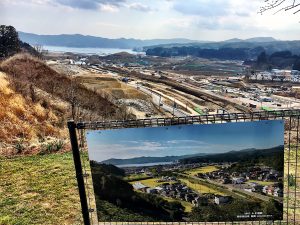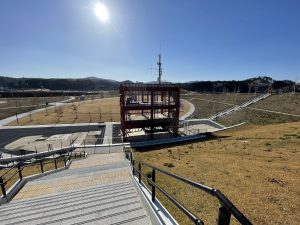This piece is the seventh in the JAWS online series of Reflections from Tōhoku
When I started visiting the areas in Northeast Japan (Tōhoku) affected by the 3.11 disaster, I was living in Tokyo, doing my post-doc at Sophia University. By the end of 2015, almost five years had passed since the disaster, the rubble had already been removed in most places and the construction of kasaage, the elevated ground on which the towns would be rebuilt, had already started. My post-doc program was part of the project “Voices from Tōhoku”, led by Prof. David Slater which explored oral narratives of the communities stricken by the disaster. When I started, the project was already ongoing, so I left Tokyo on a trip to Tōhoku to observe the places of the research and find a topic to focus on. The first town I visited was Minamisanriku in Miyagi prefecture. The landscape was surreal, the routes changed very often due to construction works, and getting one’s bearings was very difficult even for locals. My contacts with the local population started through volunteer activities (organizing charity events and seaweed processing) that brought me closer to the communities in Minamisanriku but also in Ishinomaki (Miyagi prefecture) and in Rikuzentakata and Ofunato (Iwate prefecture). I visited these areas several times between December 2015 and March 2018, with some follow-up information gathered between February and March 2019, and March of 2021. During my first visit, I came to learn about the activities of kataribe (語り部), the storytellers of the disaster, at Hotel Kanyo where I was participating in a charity event. As someone who was interested in cultural memory and in the role of storytelling in the formation of group identity I started to focus on the activities of kataribe in Minamisanriku.


View of the construction works in Shizugawa (Minamisanriku) from the
Shizugawa Junior High School in March 2016 (left) and May 2019 (right). Photos: Flavia Fulco.
Kataribe is not a phenomenon unique to Tōhoku. The practice of kataribe telling stories is actually ancient in Japanese culture (Sato, 2013) and these practices are present in sites related to WWII such as Hiroshima and Nagasaki (Yoneyama, 1999, 85-111), other disaster areas (Takano and Atsumi, 2007; Ikeda, 2013) and heritage sites (Osawa, 2007).
It was through the words of kataribe that I came to know the stories of the disaster, the life of the communities as they were before it happened and the challenges that local populations were facing in the aftermath of the disaster. Kataribe are people that usually work for tourism associations or private companies related to the leisure industry, but they can also be individuals who volunteer their time to share the story of the 3.11 disaster and their personal experiences to visitors. Despite the phenomenon of kataribe being related to the presence of outside visitors, kataribe are not tourist guides. Rather, they focus on transmitting the lessons learned from the disaster and presenting their communities to those who did not know them before.
I asked Kazuma Goto, director of the Fukko Minasan Kai association and instructor of kataribe guides about what makes kataribe unique. His answer was that compared to tourist guides, kataribe do not focus on geographical and historical data; rather their importance lies in narrating the experience of the disaster and conveying to the audience their emotions: “Kataribe is not about data. Numbers and statistics can be read in the newspaper. In kataribe, facts, personal stories, and feelings are mixed, as in ancient traditional kataribe” (Fulco, 2017).

Kataribe in Rikuzentakata October 2017. Photo: Flavia Fulco.
Kataribe play a crucial role in the communities affected by the disaster. As Nagamatsu et al (2021) show, disaster storytelling has become a tool to build a more resilient society. Not only does it promote the economic revival of the communities affected but, by transmitting the experiences of those who lived (or died) through the disaster, it has also become a very effective tool for disaster education. At first, kataribe narratives focused mostly on what happened during the disaster to outside visitors, but through the years they started to include more details about local resources and traditions, narrating Tōhoku to make it appealing to visitors, attracting newcomers, and thus providing support to the local economy. In fact, while kataribe visits are generally very cheap, visitors contribute to the local economy by staying over in the area for at least one night, eating in restaurants and buying souvenirs.

Kataribe bus tour from Hotel Kanyo March 2016. Photo: Flavia Fulco.
Kataribe is connected to the existence or absence of places and ruins left by the disaster. One example is the Minamisanriku Disaster Prevention Office Building (防災対策庁舎). Fifty people were in the Disaster Prevention Office Building when the tsunami hit. Most of them fled to the rooftop which was an official evacuation spot. However, they did not expect the actual scale of the tsunami to be so huge. It is calculated that the waves reached approximately 16 meters in this area, completely submerging the building. Forty-three people died and just seven were able to save their lives by clinging to the lateral stairways. The controversial story of this place is explicit in the narrative of one kataribe from the Hotel Kanyō tour which I joined in March of 2016: “I’m also from this town, and they say a lot of things to me, like why you show people around here. There are people that want to keep it, others that want it to be destroyed. It has been decided that a final decision will be made in 15 years to give us time to discuss it. But even so it’s useless (ダメだね). In any case, people that don’t want to see it don’t want to see it. So why do I bring people here? Of course I want to show this place. A lot of people died here, this is true, but looking at this building you have a real feeling (実感) of the importance of human life. This is the place to remember(あたたかい想いを作る場所だな). Indeed we don’t want it to be forgotten, right?” (Fieldnotes, March 2016).
In the words of this kataribe, the ruins of the Disaster Prevention Office Building were considered “the only place left to pray [for the victims]”. (手を合わせていただける場所、今はここしか残っていないんです). In the social dilemma between those who wanted to preserve the building and those who wanted it destroyed, Miyagi prefecture decided to preserve it for 20 years to give the community more time to discuss its future. Now that 10 years have passed, however, no decision has been made. And as far as I was told, the issue has not yet been discussed publicly.

Disaster Prevention Office Building as it appears in March 2016. Photo: Flavia Fulco.
Despite this indecision, the building occupies a place in the Minamisanriku Memorial Park of the Earthquake Disaster (南三陸町震災復興祈念公園) which opened in October of 2020, amidst the pandemic. In the new park, the Disaster Prevention Office ruins are difficult to access. The course of the Hachiman river was changed during the construction works and currently the river runs between the shopping district and the Memorial Park. Levees were built to protect its course, and the one on the right bank faces the façade of the remains of the Disaster Prevention Office Building. Given this new layout, to face the building people have to stand on a platform located on higher ground. Now the visitors have to look at it top-down. According to kataribe I talked to in March of 2021, people feel uncomfortable because they think this is not something to literally look down upon(見下ろせて、手合わせて、すごい違和感ありました).
The strength of the message of kataribe is highly connected to the importance of having a place to remember. In fact, the locations included in kataribe tours give a common power to their stories. Most sites were chosen either because people died there or were saved, or because of their value as monuments. Stories usually start with a description of what people were doing at the time of the earthquake and what happened between the earthquake and the tsunami. They contextualize that day as a normal day for each individual in the community—a day that started as every other, but in which life, as they knew it, was lost forever in a very short time. Protecting human life and defending the essence of everyday ‘normality’—当たり前のもの—are values often stressed during kataribe tours.
Kataribe tours have a special importance in shaping the memories around which new communities will rebuild their post-disaster identity. They contribute dramatically to mark a territory, which, at least in some towns, is being rebuilt—and before that, rethought—from zero. The stories of kataribe are important to present the community to outside visitors and provide important roles in the reconstruction. At the same time, they accompany the process of forming and consolidating a collective memory (Halbwachs 1992) of the disaster by weaving traumatic experiences into local identity.



Views of the Disaster Prevention Office Building in the Minamisanriku Memorial Park, March 2021. Photos: Flavia Fulco.
Flavia Fulco is an Italian researcher based in Japan between 2011-2021. She is currently Visiting Assistant Professor at Tohoku University in the International Institute of Disaster Science. She has a PhD in American Studies (Humanities/Cultural Anthropology) and her research focuses on the cultural memory of disasters. Specifically, she looks at the ways in which the personal memories of the disaster are transmitted through storytelling and written collections of personal narratives.
Acknowledgment: Part of the author’s fieldwork was funded by the Toshiba International Foundation Grant (2018 and 2019).
Editor’s note: the article originally stated that the Yawata river runs by the Minamisanriku Memorial Park. It is not the Yawata river, but the Hachiman river. The article has been updated to reflect this.
References
Fulco, F. (2017): “Kataribe. A Keyword to Recovery”. Japan-Insights website (topics.japan-insights.jp/#kataribe).
Halbwachs, M. (1992) On Collective Memory. Chicago: University of Chicago Press.
Ikeda, R. (2013). Minamatabyō/ minamatabyō jiken o kataritsugu tame no mosaku: Taiwa keishiki no katari no ba no kanōsei. (The Pursuit of the Appropriate “Ba (Place)” for Constructing Meanings of Minamata Disease Incidents: Examining Dialogue-type Sessions between “Kataribe (Narrators)” and “Assistant”.) Speech Communication Education26:5-23.
Nagamatsu, S. Fukusawa, Y. Kobayashi, I. (2021) “Why does storytelling matter for a resilient society?” Journal of Disaster Research, 16(2), pp. 127-134.
Osawa, T. (2007). Seikaiisan chiiki ni okeru goribu gaido no genjō ni tsuite (On the current situation of the kataribe/guides at a world heritage site). Chiiki kenkyū shirīzu (Regional Studies Series) 32: 1-23.
Sato, K. (2013) Mukashibanashi no kōshō to chiiki gakushū no tenkai: Iwate ken Tōno-shi no `minwa no furusato’-tzukuri to goribu-tachi no katsudō. (Citizens’Oral Activities of Folk Tale and Development of Community Learning: A Case Study of Community Development of City of Tono in the Iwate Prefecture as a “Home Village of Folk Tale) Kyaria dezain gakubu kiyō (Bulletin of Faculty of Career Design)10: 339-82.
Takano, N. and Atsumi, T. (2007) Hanshin Awaji daishinsai no goribu to kikite no taiwa ni kansuru ichikōsatsu – taiwa no hokorobi o megutte. (An Examination of the Dialogue with the Narrators and Audiences of the Great Hanshin-Awaji Earthquake: From several cases of the rips of the narrator’s talks and audiences). The Japanese Journal of Experimental Social Psychology 46: 185-197.
Yoneyama, L. (1999) Hiroshima Traces, Berkeley and Los Angeles: University of California Press.
